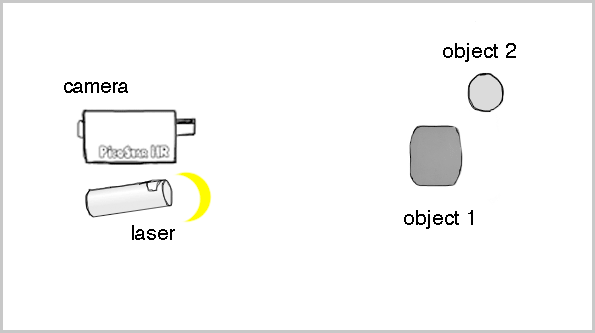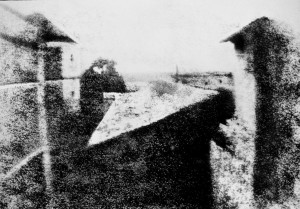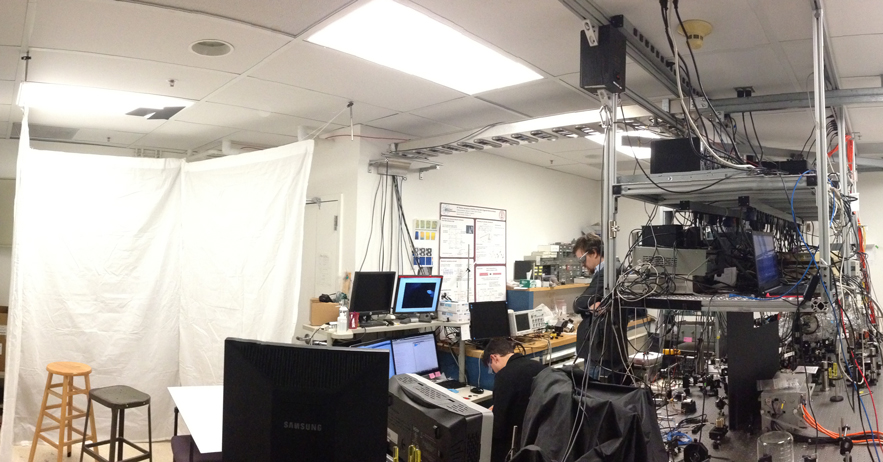INFO
PHOTOGRAPHY AT THE SPEED OF LIGHT: THE BASICS
Most objects we see because light that is scattered off those objects reaches our eye and is imaged onto our retina. If we have a pulsed light source, one that we can switch on and off very fast, then we only see the object during the short time in which the pulsed scattered light reaches our eye (or our camera). The distance between light source, object and detector will determine the time at which the scattered pulse reaches the eye (or the camera). Objects that are further away from the source and detector will be imaged at a later time.

In the animation this means that light scattered from object 1 will arrive at the detector earlier than light scattered from object 2. As light travels at a high speed it needs a very short pulse of light and a high speed camera to record that effect.
In fact light travels at a fast but finite speed of 299 792 458 meters per second. In astronomy this often leads to measurable delays due to the large distances between stars, planets and galaxies. For example, it takes light about 8 minutes and 20 seconds to travel from the sun to the earth. However, it takes only 3 billionths of a second (0.000 000 003 seconds) for light to travel the distance of one meter, which is why we never experience the movement of light in our daily lives. Our sense of vision is simply not fast enough.
With the help of modern technology we can take pictures with exposure times as short as 0.1 billionths of a second. This allows us to record the movement of light across a subject. Light is now more than illumination, it becomes the protagonist of our images, we can literally watch light write an image.
SHORT HISTORY OF HIGH SPEED PHOTOGRAPHY

The earliest surviving photograph, View from the Window at Le Gras by Nicéphore Niépce, was created in 1826. Using a camera obscura, Nièpce needed an exposure time of more than eight hours in order to record the light scattered into his camera and onto a metal plate covered with light-sensitive chemicals.
Long exposure times made it difficult to capture a “picture of reality”, as motion would blur the image. Consequently, many experiments were carried out in order to find the materials and techniques that would allow shorter exposure times.

One of the pioneers of fast photography was Eadweard Muybridge. In 1878 he recorded a series of pictures showing one of Leland Stanford’s horses on his farm in Palo Alto. Muybridge reached exposure times on the order of one millisecond and his photographs provided insight in the fast motion of horses, humans and various animals. Many important developments followed and the short exposures reached by Muybridge are nowadays standard in cameras.
SEEC PHOTOGRAPHY
Light travels about 30 cm within one billionth of a second (0.000 000 001 sec). If we want to image the motion of light across human-sized objects, we need cameras with shutter times a million times shorter than those used by Muybridge. In addition to that, we need a short pulse of light to start out with. The relevant technology (pulsed lasers and gated cameras) were developed during the last few decades and led to many scientific advances. One of them is LIDAR, where distances are measured by measuring the arrival times of scattered light. Some work that inspired us was the imaging of a light pulse in a scattering fluid [1] and a movie showing light moving through a coke bottle [2]. More relevant work can be found in the references given in [3]. We use this new technique to record light moving across subjects that represent traditional photographic themes, like the portrait or the still life. Thus, the main character of these archetypical forms of photography is not the subject standing in front of the camera but light itself, travelling across the objects, being scattered and reflected off surfaces. We called our project SEEC Photography, as the speed of light is usually referred to by the letter ‘c’, as in the famous equation E=mc².
OUR EQUIPMENT
Short Illumination
A common flash used in photography creates light pulses that are about 0.1 milliseconds short. That is a thousand times shorter than the blink of an eye but almost a million times too long for our purpose. Instead, we use a pulsed laser (a mode-locked titanium sapphire laser) that emits pulses of light that are only 30 billionths of a millionth of a second short (0.000 000 000 000 03 seconds). This is much shorter than required, which is why we lengthen the pulses considerably for laser safety considerations. Even after lengthening the pulses, what limits the temporal resolution in our apparatus is not the length of the laser pulses but the shutter time of the camera we are using (~100 ps).
Fast and Sensitive Detection
To detect the scattered light at ultra-short exposure times we use a gated and intensified camera. In such a camera, the incoming light is first converted to electrons. These electrons, basically an electric current, can be steered and gated using rapidly varying electric fields. Only within a short time window, the current is steered towards an amplifying stage and subsequently converted back into light, which is imaged using a standard camera. The gating allows for shutter times down to 0.1 billionths of a second and the amplification allows for the detection of single photons, the quanta of light. During such a short time, only a few photons reach the camera, which is why we repeat the exposure many times to form an image. This sets constraints on the synchronisation of our laser pulses with the camera, and requires our models to hold still for a while, typically for a few minutes for one of our movies.

[1] Michel A. Duguay, ‘The ultrafast optical Kerr shutter’, Bell laboratories 1976; See page 178 and 179!!!!
[2] https://www.youtube.com/watch?v=EtsXgODHMWk
[3] https://en.wikipedia.org/wiki/Light-in-flight_imaging